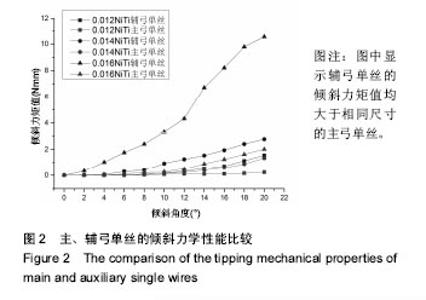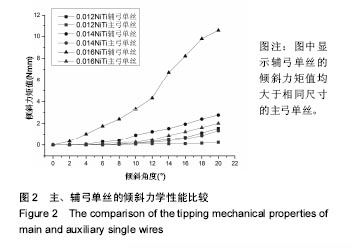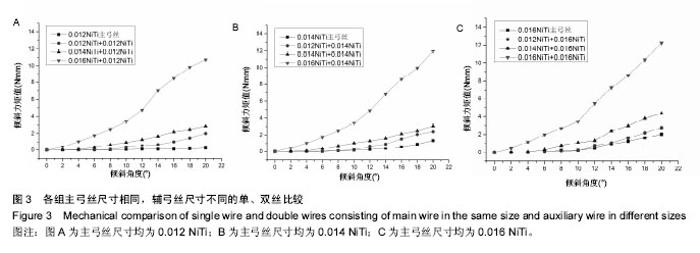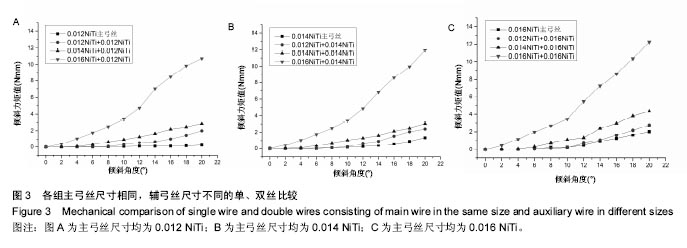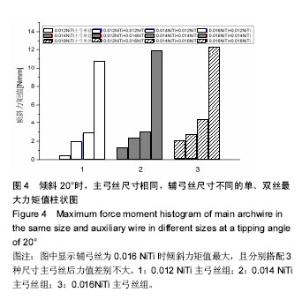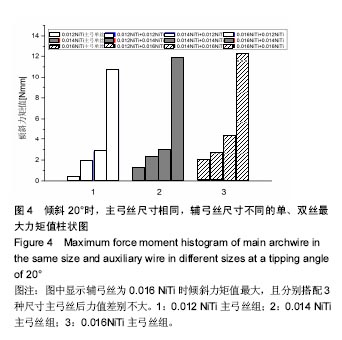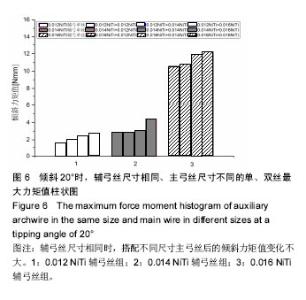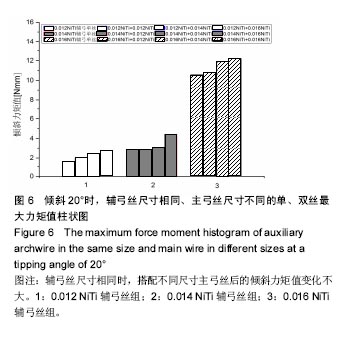Chinese Journal of Tissue Engineering Research ›› 2017, Vol. 21 ›› Issue (34): 5449-5454.doi: 10.3969/j.issn.2095-4344.2017.34.007
Previous Articles Next Articles
A three-dimensional finite element analysis of the tip mechanical capabilities of self-ligating brackets with double wires
- Hospital of Stomatology, Southwest Medical University, Luzhou 646000, Sichuan Province, China
-
Received:2017-11-01Online:2017-12-08Published:2018-01-04 -
Contact:Huang Yue, M.D., Associate professor, Master’s supervisor, Hospital of Stomatology, Southwest Medical University, Luzhou 646000, Sichuan Province, China -
About author:Zhou Rong, Studying for master’s degree, Physician, Hospital of Stomatology, Southwest Medical University, Luzhou 646000, Sichuan Province, China -
Supported by:the Youth Project of Sichuan Provincial Medical Association, No. [2016]2; the Basic Research Project supported by the Sichuan Provincial Department of Human Resources and Social Security, No. [2015]93; the Project of Southwest Medical University, No. [2016]217-2016145
CLC Number:
Cite this article
Zhou Rong, He Song, Wu Xi, Bai Rui, He Han, Huang Yue.
share this article
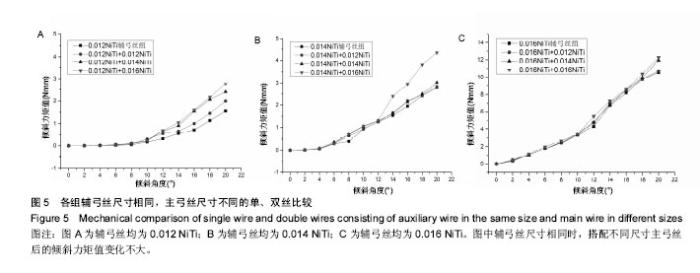
2.2.2 辅弓丝尺寸相同,主弓丝尺寸不同的单、双丝倾斜力学性能对比 单丝组中,0.012 ,0.014,0.016英寸的主弓单丝出现拐点的角度较大,分别约为8°,8°,6°(图2);双丝组中,随着辅弓丝的应用及其尺寸的增加其拐点出现提前,辅弓丝为0.012,0.014,0.016英寸的圆-圆双丝出现拐点均约为6°,4°,0.5°(图5)。另外,当不同尺寸主弓丝配以同尺寸辅弓丝时,各载荷曲线图显示当辅弓丝尺寸不变时,倾斜力矩值随主弓丝尺寸的增大而增大,但其变化甚小;同时,倾斜力矩值也随倾斜角度增加而增大,但不同尺寸主弓丝间的力值变化不大(图6)。由此,与图2-4相比,可以看出双丝系统倾斜力矩值的变化受主弓丝尺寸的影响小于辅弓丝。"
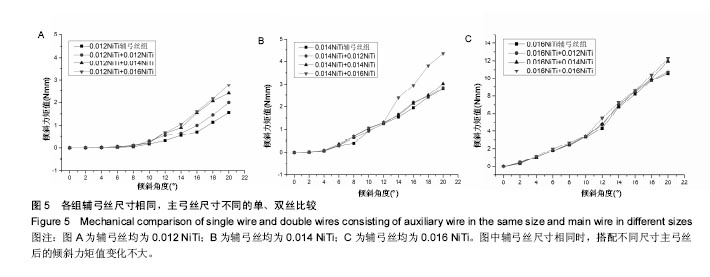
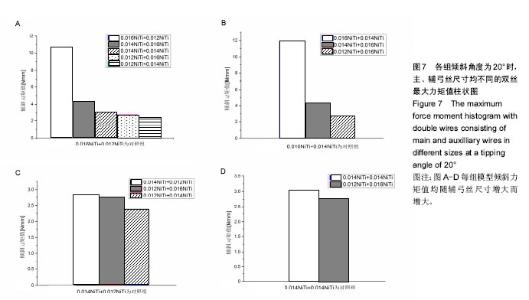
2.2.3 主、辅弓丝尺寸均不同的双丝组合的倾斜力学性能对比 倾斜角度20°时,主弓丝和辅弓丝较对照组均不相同的双丝组合的倾斜力学性能比较。实验以辅弓丝尺寸小于对照组,主弓丝尺寸大于对照组的方式进行分组,为A,B,C,D组。按:A组以16NiTi+12NiTi为对照组,双丝组合的辅弓丝均为小于0.016英寸的镍钛圆丝,主弓丝均为大于0.012英寸的镍钛圆丝,共有5个模型;B组以16NiTi+14NiTi为对照组,共3个模型;C组以14NiTi+12NiTi为对照组,共3个模型;D组以14NiTi+14NiTi为对照组,共2个模型。实验结果如图7所示,每组模型倾斜力矩值均随辅弓丝尺寸增大而增大。"
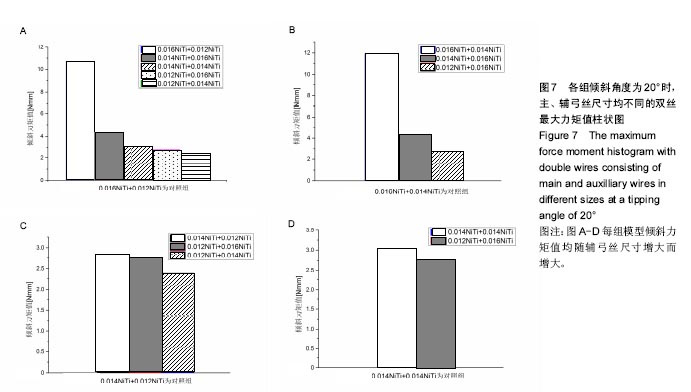
| [1]沈刚,陈荣敬,潘晓岗,等.双排沟托槽力学性能的初步实验分析[J].中华口腔正畸学杂志,2003,10(3):112-116.[2]武秀萍,HEE Moon Kyung,李冰,等."微种植体支抗双槽沟舌侧托槽"矫治系统前牙移动的磁感应Typodont实验[J].中国组织工程研究,2017, 21(22):3525-3530.[3]赵志河.自锁托槽的临床应用及相关问题[J].口腔医学,2017,37(1):1-4.[4]Major TW, Carey JP, Nobes DS, et al. Mechanical effects of third-order movement in self-ligated brackets by the measurement of torque expression. Am J Orthod Dentofacial Orthop. 2011;139(1):31-44.[5]Major TW, Carey JP, Nobes DS, et al. Measurement of plastic and elastic deformation due to third-order torque in self-ligated orthodontic brackets. Am J Orthod Dentofacial Orthop. 2011;140(3):326-339.[6]Alobeid A, Elbialy T, Khawatmi S, et al. Comparison of the force levels among labial and lingual self-ligating and conventional brackets in simulated misaligned teeth. Eur J Orthod. 2017. DOI:10.1093/ejo/cjw082.[7]Rino NJ, Queiroz GV, de Paiva JB, et al. Does self-ligating brackets type influence the hysteresis, activation and deactivation forces of superelastic NiTi archwires? Dental Press J Orthod. 2013;18(1):81-85.[8]Al FH, Carey JP, Melenka GW, et al. Investigation into the effects of stainless steel ligature ties on the mechanical characteristics of conventional and self-ligated brackets subjected to torque. J Orthod. 2014;41(3):188-200.[9]Archambault A, Major TW, Carey JP, et al. A comparison of torque expression between stainless steel, titanium molybdenum alloy, and copper nickel titanium wires in metallic self-ligating brackets. Angle Orthodontist. 2010;80(5):884-889.[10]Major TW, Carey JP, Nobes DS, et al. Deformation and warping of the bracket slot in select self-ligating orthodontic brackets due to an applied third order torque. J Orthod. 2012;39(1):25-33.[11]Huang Y, Keilig L, Rahimi A, et al. Numeric modeling of torque capabilities of self-ligating and conventional brackets. Am J Orthod Dentofacial Orthop. 2009;136(5):638-643.[12]Rhoden FK, Maltagliati LÁ, de Castro Ferreira Conti AC, et al. Cone beam computed tomography-based evaluation of the anterior teeth position changes obtained by passive self-ligating brackets. J Contemp Dent Pract. 2016;17(8):623.[13]Lineberger MB, Franchi M, Cevidanes LHS, et al. Three-dimensional digital cast analysis of the effects produced by a passive self-ligating system. Eur J Orthod. 2016;2016(6):1-6.[14]Zhang DP, Liu J, Liu Y, et al. Influence of self-ligating and conventional brackets on dental arch width in non-extraction treatment: a meta analysis. Shanghai Kou Qiang Yi Xue. 2014;23(3):367.[15]Heo W, Baek SH. Friction properties according to vertical and horizontal tooth displacement and bracket type during initial leveling and alignment. Angle Orthodontist. 2011;81(4):653-661.[16]Kannan MS, Murali RV, Kishorekumar S, et al. Comparison of frictional resistance of esthetic and semi-esthetic self-ligating brackets. J Pharm Bioallied Sci. 2015;7(1):116-120.[17]Fathimani M, Melenka GW, Romanyk DL, et al. Development of a standardized testing system for orthodontic sliding mechanics. Prog Orthod. 2015;16(1):14.[18]陈明珠,沈绍莹,尹康,等.双丝弓技术在不同自锁托槽中摩擦力的测量分析[J].昆明医科大学学报,2016,(11):93-96.[19]巫云霞,卜寿山,尹林,等.Damon Q自锁托槽矫治器和传统直丝弓托槽矫治器临床疗效对比研究[J].南京医科大学学报(自然科学版), 2016,37(8): 1015-1016.[20]Savoldi F, Visconti L, Dalessandri D, et al. In vitro evaluation of the influence of velocity on sliding resistance of stainless steel arch wires in a self-ligating orthodontic bracket. Orthod Craniofac Res. 2017; 20(2):119-125.[21]Pillai AR, Anil G, Satheesh K, et al. Comparison of the frictional resistance between archwire and different bracket system: An in vitro study. J Pharm Bioallied Sci. 2014;6(1):150-155.[22]Leite VV, Lopes MB, Gonini JA, et al. Comparison of frictional resistance between self-ligating and conventional brackets tied with elastomeric and metal ligature in orthodontic archwires. Dental Press J Orthod. 2014;19(3):114-119.[23]Muguruma T, Iijima M, Brantley WA, et al. Effects of third-order torque on frictional force of self-ligating brackets. Angle Orthodontist. 2014; 84(6):1054-1061.[24]吴雪,何淞,杨钦佩,等.双槽沟被动自锁系统扭转性能的三维有限元分析[J].口腔医学研究,2017,33(1):42-46.[25]Butti AC, Mangiacapra R, Saporito I,et al. Second order root control of self-ligating brackets and traditional brackets: a "typodont" study. Minerva Stomatol. 2014;63(3):51-57.[26]Iijima M, Muguruma T, Brantley WA, et al. Comparisons of nanoindentation, 3-point bending, and tension tests for orthodontic wires. Am J Orthod Dentofacial Orthop. 2011;140(1):65-71.[27]Tominaga J, Chiang PC, Ozaki H, et al. Effect of play between bracket and archwire on anterior tooth movement in sliding mechanics: a three-dimensional finite element study. J Dent Biomech. 2012;3(1): 1758736012461269.[28]Pelsue BM, Zinelis S, Bradley TG, et al. Structure, Composition, and Mechanical Properties of Australian Orthodontic Wires. Angle Orthod. 2009;79(1):97-101.[29]Proffit WR. Contemporary Orthodontics. The C.V. Mosby Company. St.Louis. 1986. DOI:10.1038/sj.bdj.2012.829.[30]Meling TR, Odegaard J. The effect of cross-sectional dimensional variations of square and rectangular chrome-cobalt archwires on torsion. Angle Orthod. 1998;68(3):239-248.[31]Arreghini A, Lombardo L, Mollica F, et al. Torque expression capacity of 0.018 and 0.022 bracket slots by changing archwire material and cross section. Prog Orthod. 2014;15(1):53. |
| [1] | Wei Guoqiang, Li Yunfeng, Wang Yi, Niu Xiaofen, Che Lifang, Wang Haiyan, Li Zhijun, Shi Guopeng, Bai Ling, Mo Kai, Zhang Chenchen, Xu Yangyang, Li Xiaohe. Biomechanical analysis of non-uniform material femur under different loads [J]. Chinese Journal of Tissue Engineering Research, 2022, 26(9): 1318-1322. |
| [2] | Zhang Yufang, Lü Meng, Mei Zhao. Construction and verification of a full spine biomechanical model of adolescent scoliosis [J]. Chinese Journal of Tissue Engineering Research, 2022, 26(9): 1351-1356. |
| [3] | Zhang Jichao, Dong Yuefu, Mou Zhifang, Zhang Zhen, Li Bingyan, Xu Xiangjun, Li Jiayi, Ren Meng, Dong Wanpeng. Finite element analysis of biomechanical changes in the osteoarthritis knee joint in different gait flexion angles [J]. Chinese Journal of Tissue Engineering Research, 2022, 26(9): 1357-1361. |
| [4] | Yao Xiaoling, Peng Jiancheng, Xu Yuerong, Yang Zhidong, Zhang Shuncong. Variable-angle zero-notch anterior interbody fusion system in the treatment of cervical spondylotic myelopathy: 30-month follow-up [J]. Chinese Journal of Tissue Engineering Research, 2022, 26(9): 1377-1382. |
| [5] | An Weizheng, He Xiao, Ren Shuai, Liu Jianyu. Potential of muscle-derived stem cells in peripheral nerve regeneration [J]. Chinese Journal of Tissue Engineering Research, 2022, 26(7): 1130-1136. |
| [6] | Zhang Jinglin, Leng Min, Zhu Boheng, Wang Hong. Mechanism and application of stem cell-derived exosomes in promoting diabetic wound healing [J]. Chinese Journal of Tissue Engineering Research, 2022, 26(7): 1113-1118. |
| [7] | Wen Mingtao, Liang Xuezhen, Li Jiacheng, Xu Bo, Li Gang. Mechanical stability of Sanders II type calcaneal fractures fixed by two internal fixation methods [J]. Chinese Journal of Tissue Engineering Research, 2022, 26(6): 838-842. |
| [8] | Wang Hailong, Li Long, Maihemuti·Yakufu, Chen Hongtao, Liu Xu, Yilihamu·Tuoheti. Finite element analysis of stress distribution of acetabular prosthesis in the Lewinnek safety zone [J]. Chinese Journal of Tissue Engineering Research, 2022, 26(6): 843-847. |
| [9] | Wei Bing, Chang Shan. Finite element analysis of different angles of nail placement in sagittal plane of spinal fracture [J]. Chinese Journal of Tissue Engineering Research, 2022, 26(6): 864-869. |
| [10] | Li Guijun, Fang Xiaohui, Kong Weifeng, Yuan Xiaoqing, Jin Rongzhong, Yang Jun. Finite element analysis of the treatment of hallux valgus deformity by microplate combined with super strong suture elastic fixation [J]. Chinese Journal of Tissue Engineering Research, 2022, 26(6): 938-942. |
| [11] | He Yunying, Li Lingjie, Zhang Shuqi, Li Yuzhou, Yang Sheng, Ji Ping. Method of constructing cell spheroids based on agarose and polyacrylic molds [J]. Chinese Journal of Tissue Engineering Research, 2022, 26(4): 553-559. |
| [12] | He Guanyu, Xu Baoshan, Du Lilong, Zhang Tongxing, Huo Zhenxin, Shen Li. Biomimetic orientated microchannel annulus fibrosus scaffold constructed by silk fibroin [J]. Chinese Journal of Tissue Engineering Research, 2022, 26(4): 560-566. |
| [13] | Baibujiafu·Yelisi, Renaguli·Maihemuti, Aizimaitijiang·Saiyiti, Wang Junxiang, Nijiati·Tuerxun. Stress analysis of maxillary central incisor crown implant restoration in different occlusal modes [J]. Chinese Journal of Tissue Engineering Research, 2022, 26(4): 567-572. |
| [14] | Wang Can, Gu Weiping, Jiang Yubin, Zhu Lin, Chen Gang. Finite element analysis of the influence of different implant designs on the stress of mandibular edentulous jaw [J]. Chinese Journal of Tissue Engineering Research, 2022, 26(4): 573-578. |
| [15] | Zhang Jianguo, Chen Chen, Hu Fengling, Huang Daoyu, Song Liang. Design and biomechanical properties of dental implant pore structure based on three-dimensional finite element analysis [J]. Chinese Journal of Tissue Engineering Research, 2022, 26(4): 585-590. |
| Viewed | ||||||
|
Full text |
|
|||||
|
Abstract |
|
|||||
